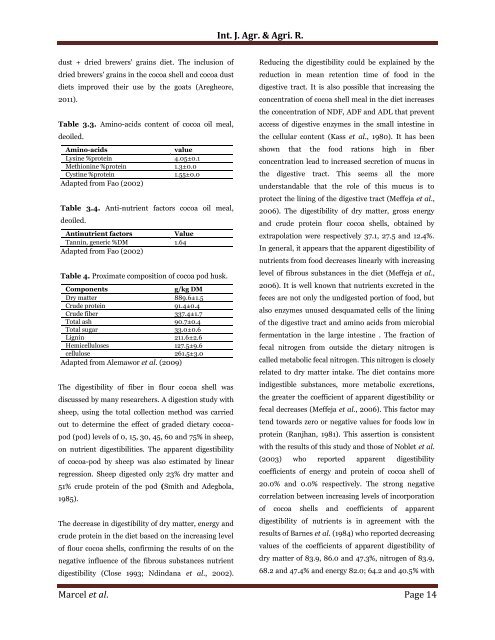Waste and by-products of cocoa in breeding: Research synthesis
This review aims to show the potential nutritional waste and by-products of cocoa in animals through scientific studies. Indeed, research indicates that the waste and by-products generally contain cocoa 12-17% protein, major minerals (Ca, P, K, Na) and fibers that predispose them to feed. Tested in ruminants, chickens, snails, pigs and rabbits, they have been beneficial to low levels. Because these foods contain theobromine, antintritionnel factor, witch limits their use in livestock. However, appropriate treatments can help to increase the quantities of waste and by-products of cocoa in animal diets.
This review aims to show the potential nutritional waste and by-products of cocoa in animals through scientific studies. Indeed, research indicates that the waste and by-products generally contain cocoa 12-17% protein, major minerals (Ca, P, K, Na) and fibers that predispose them to feed. Tested in ruminants, chickens, snails, pigs and rabbits, they have been beneficial to low levels. Because these foods contain theobromine, antintritionnel factor, witch limits their use in livestock. However, appropriate treatments can help to increase the quantities of waste and by-products of cocoa in animal diets.
Create successful ePaper yourself
Turn your PDF publications into a flip-book with our unique Google optimized e-Paper software.
Int. J. Agr. & Agri. R.<br />
dust + dried brewers' gra<strong>in</strong>s diet. The <strong>in</strong>clusion <strong>of</strong><br />
dried brewers' gra<strong>in</strong>s <strong>in</strong> the <strong>cocoa</strong> shell <strong>and</strong> <strong>cocoa</strong> dust<br />
diets improved their use <strong>by</strong> the goats (Aregheore,<br />
2011).<br />
Table 3.3. Am<strong>in</strong>o-acids content <strong>of</strong> <strong>cocoa</strong> oil meal,<br />
deoiled.<br />
Am<strong>in</strong>o-acids<br />
value<br />
Lys<strong>in</strong>e %prote<strong>in</strong> 4.05±0.1<br />
Methion<strong>in</strong>e %prote<strong>in</strong> 1.3±0.0<br />
Cyst<strong>in</strong>e %prote<strong>in</strong> 1.55±0.0<br />
Adapted from Fao (2002)<br />
Table 3.4. Anti-nutrient factors <strong>cocoa</strong> oil meal,<br />
deoiled.<br />
Ant<strong>in</strong>utrient factors<br />
Value<br />
Tann<strong>in</strong>, generic %DM 1.64<br />
Adapted from Fao (2002)<br />
Table 4. Proximate composition <strong>of</strong> <strong>cocoa</strong> pod husk.<br />
Components<br />
g/kg DM<br />
Dry matter 889.6±1.5<br />
Crude prote<strong>in</strong> 91.4±0.4<br />
Crude fiber 337.4±1.7<br />
Total ash 90.7±0.4<br />
Total sugar 33.0±0.6<br />
Lign<strong>in</strong> 211.6±2.6<br />
Hemicelluloses 127.5±9.6<br />
cellulose 261.5±3.0<br />
Adapted from Alemawor et al. (2009)<br />
The digestibility <strong>of</strong> fiber <strong>in</strong> flour <strong>cocoa</strong> shell was<br />
discussed <strong>by</strong> many researchers. A digestion study with<br />
sheep, us<strong>in</strong>g the total collection method was carried<br />
out to determ<strong>in</strong>e the effect <strong>of</strong> graded dietary <strong>cocoa</strong>pod<br />
(pod) levels <strong>of</strong> 0, 15, 30, 45, 60 <strong>and</strong> 75% <strong>in</strong> sheep,<br />
on nutrient digestibilities. The apparent digestibility<br />
<strong>of</strong> <strong>cocoa</strong>-pod <strong>by</strong> sheep was also estimated <strong>by</strong> l<strong>in</strong>ear<br />
regression. Sheep digested only 23% dry matter <strong>and</strong><br />
51% crude prote<strong>in</strong> <strong>of</strong> the pod (Smith <strong>and</strong> Adegbola,<br />
1985).<br />
The decrease <strong>in</strong> digestibility <strong>of</strong> dry matter, energy <strong>and</strong><br />
crude prote<strong>in</strong> <strong>in</strong> the diet based on the <strong>in</strong>creas<strong>in</strong>g level<br />
<strong>of</strong> flour <strong>cocoa</strong> shells, confirm<strong>in</strong>g the results <strong>of</strong> on the<br />
negative <strong>in</strong>fluence <strong>of</strong> the fibrous substances nutrient<br />
digestibility (Close 1993; Nd<strong>in</strong>dana et al., 2002).<br />
Reduc<strong>in</strong>g the digestibility could be expla<strong>in</strong>ed <strong>by</strong> the<br />
reduction <strong>in</strong> mean retention time <strong>of</strong> food <strong>in</strong> the<br />
digestive tract. It is also possible that <strong>in</strong>creas<strong>in</strong>g the<br />
concentration <strong>of</strong> <strong>cocoa</strong> shell meal <strong>in</strong> the diet <strong>in</strong>creases<br />
the concentration <strong>of</strong> NDF, ADF <strong>and</strong> ADL that prevent<br />
access <strong>of</strong> digestive enzymes <strong>in</strong> the small <strong>in</strong>test<strong>in</strong>e <strong>in</strong><br />
the cellular content (Kass et al., 1980). It has been<br />
shown that the food rations high <strong>in</strong> fiber<br />
concentration lead to <strong>in</strong>creased secretion <strong>of</strong> mucus <strong>in</strong><br />
the digestive tract. This seems all the more<br />
underst<strong>and</strong>able that the role <strong>of</strong> this mucus is to<br />
protect the l<strong>in</strong><strong>in</strong>g <strong>of</strong> the digestive tract (Meffeja et al.,<br />
2006). The digestibility <strong>of</strong> dry matter, gross energy<br />
<strong>and</strong> crude prote<strong>in</strong> flour <strong>cocoa</strong> shells, obta<strong>in</strong>ed <strong>by</strong><br />
extrapolation were respectively 37.1, 27.5 <strong>and</strong> 12.4%.<br />
In general, it appears that the apparent digestibility <strong>of</strong><br />
nutrients from food decreases l<strong>in</strong>early with <strong>in</strong>creas<strong>in</strong>g<br />
level <strong>of</strong> fibrous substances <strong>in</strong> the diet (Meffeja et al.,<br />
2006). It is well known that nutrients excreted <strong>in</strong> the<br />
feces are not only the undigested portion <strong>of</strong> food, but<br />
also enzymes unused desquamated cells <strong>of</strong> the l<strong>in</strong><strong>in</strong>g<br />
<strong>of</strong> the digestive tract <strong>and</strong> am<strong>in</strong>o acids from microbial<br />
fermentation <strong>in</strong> the large <strong>in</strong>test<strong>in</strong>e . The fraction <strong>of</strong><br />
fecal nitrogen from outside the dietary nitrogen is<br />
called metabolic fecal nitrogen. This nitrogen is closely<br />
related to dry matter <strong>in</strong>take. The diet conta<strong>in</strong>s more<br />
<strong>in</strong>digestible substances, more metabolic excretions,<br />
the greater the coefficient <strong>of</strong> apparent digestibility or<br />
fecal decreases (Meffeja et al., 2006). This factor may<br />
tend towards zero or negative values for foods low <strong>in</strong><br />
prote<strong>in</strong> (Ranjhan, 1981). This assertion is consistent<br />
with the results <strong>of</strong> this study <strong>and</strong> those <strong>of</strong> Noblet et al.<br />
(2003) who reported apparent digestibility<br />
coefficients <strong>of</strong> energy <strong>and</strong> prote<strong>in</strong> <strong>of</strong> <strong>cocoa</strong> shell <strong>of</strong><br />
20.0% <strong>and</strong> 0.0% respectively. The strong negative<br />
correlation between <strong>in</strong>creas<strong>in</strong>g levels <strong>of</strong> <strong>in</strong>corporation<br />
<strong>of</strong> <strong>cocoa</strong> shells <strong>and</strong> coefficients <strong>of</strong> apparent<br />
digestibility <strong>of</strong> nutrients is <strong>in</strong> agreement with the<br />
results <strong>of</strong> Barnes et al. (1984) who reported decreas<strong>in</strong>g<br />
values <strong>of</strong> the coefficients <strong>of</strong> apparent digestibility <strong>of</strong><br />
dry matter <strong>of</strong> 83.9, 86.0 <strong>and</strong> 47.3%, nitrogen <strong>of</strong> 83.9,<br />
68.2 <strong>and</strong> 47.4% <strong>and</strong> energy 82.0; 64.2 <strong>and</strong> 40.5% with<br />
Marcel et al. Page 14


















